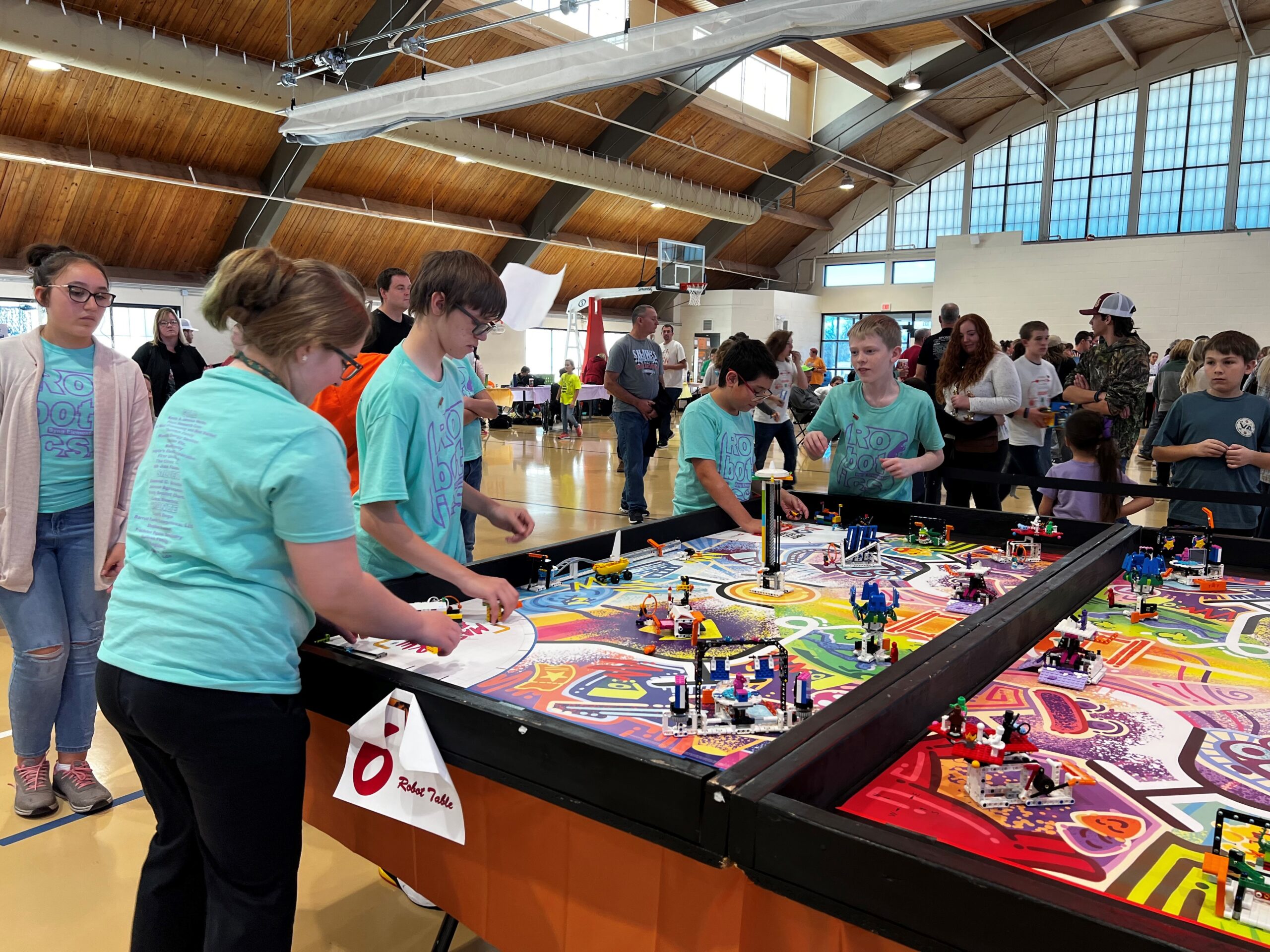
From Coding to Core Values: The Comprehensive World of Lego Robotics
January 22, 2024 by Jessika Leatherbury
By: Sunnie Dawn Baker
 When Emily Denney first started teaching at Homer Elementary, she never would have dreamed that her world would become immersed in robotics. Now, as the librarian at Byng Elementary, she, along with fourth-grade teacher and co-sponsor Hollie Fuller, and fifth grade teachers Calli Presley and Kelli Butler, dedicate a fair amount of time to thinking about robotics and how to help students maximize their experience in the program. While the fifth and sixth-grade robotics team at Byng originally concentrated on Bot Ball, a more coding-centric approach to robotics, Denney decided to transition their program to Lego robotics, and she couldn’t be happier.
When Emily Denney first started teaching at Homer Elementary, she never would have dreamed that her world would become immersed in robotics. Now, as the librarian at Byng Elementary, she, along with fourth-grade teacher and co-sponsor Hollie Fuller, and fifth grade teachers Calli Presley and Kelli Butler, dedicate a fair amount of time to thinking about robotics and how to help students maximize their experience in the program. While the fifth and sixth-grade robotics team at Byng originally concentrated on Bot Ball, a more coding-centric approach to robotics, Denney decided to transition their program to Lego robotics, and she couldn’t be happier.
Lego robotics, unlike other robotics programs, fosters more creativity and ingenuity while also encouraging skills that extend beyond the basic coding of a robot. While the change initially made some students apprehensive, they soon embraced the new possibilities offered by Legos. When the students build their robots, they start with a base structure and then use Legos to create their own designs for specific tasks. After designing their robot, they must figure out how to code it to perform the required tasks for competition. The organizers release a mystery theme and challenge for each season on August 1st. As the Fall semester begins, Denney and Fuller start accepting applications for the team, and once they set their roster, they move ahead, preparing for the first competition in November. While their program has been successful, they face a distinct disadvantage due to the timing of the challenge release. Teams that are supported by libraries or other community organizations have the added benefit of extra weeks to prepare for the competition. Nevertheless, Denney and Fuller remain unfazed because, once they have their team, the students are energized, enthusiastic, and ready to put in the work.
In addition to the extra design freedom that Lego robotics offers, the scores rely on more than just coding. Programming the robot to navigate different challenges and perform various tasks determines a quarter of each team’s score. Robot design accounts for another quarter of their score. However, the remaining fifty percent comprises their “innovation project” and demonstration of the “core values”. While Denney and Fuller are excited to see how the students design their robots and tackle the coding challenges, they are most enthusiastic about the innovation project and the lessons that it teaches. For this project, each team must devise an innovative solution to a problem and deliver a presentation. This past season the students were tasked with making a hobby more applicable to a wider audience through the use of technology. The individual teams selected baking, fishing, swimming, and rock collecting, with swimming and rock collecting advancing to the state competition.
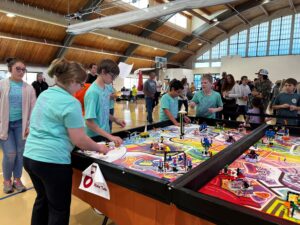 The students must research their topic, talk to experts in the field, and create a tri-fold poster explaining why they chose that topic and how they would use technology and entrepreneurship to bring their ideas to life. When they compete, they deliver a presentation to the judges, which is the most nerve-wracking part for some of the students. However, when they come through the experience, they are more confident in their abilities to explain their ideas. It also helps that the students have a lot of creative freedom when they are designing their presentation. For instance, the swimming group did a spoof on all the failed ideas they had before they came up with their real idea and the rock collecting group made theirs a skit like a paid advertisement.
The students must research their topic, talk to experts in the field, and create a tri-fold poster explaining why they chose that topic and how they would use technology and entrepreneurship to bring their ideas to life. When they compete, they deliver a presentation to the judges, which is the most nerve-wracking part for some of the students. However, when they come through the experience, they are more confident in their abilities to explain their ideas. It also helps that the students have a lot of creative freedom when they are designing their presentation. For instance, the swimming group did a spoof on all the failed ideas they had before they came up with their real idea and the rock collecting group made theirs a skit like a paid advertisement.
Through their presentation, the judges pose questions to them about the “core values” of Lego robotics which are discovery, innovation, impact, inclusion, teamwork, and fun. The judges ask the students what kind of impact their innovation could have on the world and how they tackle different challenges, both technically and as a team. They want to ensure that everyone on the team takes an active role and is included. These core values are not just for show; they make up as much of the final score as programming the robot. Lego robotics strives to build future technologists who are also good people and teammates.
Through the course of Lego robotics, the students learn to think creatively with their robot design, think analytically with their coding, and think about the world around them with their presentations and core values. This also gives students a chance to explore some of these ideas more in-depth. An excellent example of this occurred with the rock collecting group. They came up with an idea for an app that would identify rocks for aspiring collectors. Through the course of this project, the students had to research how apps are created, how much it costs to create an app, and what types of programming one would have to know. They were so excited about their project, and invested in their idea, that they met with the Byng high school STEM teacher, Josh Carlin, who took an afternoon to give them a tutorial on app creation using the MIT app creator. By the end, the students had designed the first ten pages of their own app.
On top of all the great things that Lego robotics teaches, Denney is most excited about the impact it can have on these students’ future. Denney says, “The middle school years are tricky. They are a No Man’s Land where the kids are in-between childhood and adolescence. We really hope to influence our students to move down a path of success. Lego Robotics definitely helps them envision bright futures!” For Denney, Lego robotics is about more than just education and skill building. It gives these students an opportunity for a better future and helps them see the possibilities that the world can hold.
Sign up to receive more news from the Ada Jobs Foundation HERE!
Written by
Jessika Leatherbury
You may also interested in:

Adapt and Overcome: Allison Poe’s Recipe for Resilience and Growth
By: Sunnie Dawn Baker Allison Poe has always followed her feet. She waits for the signs to appear and, once she recognizes them, she travels that path, and has never
Jeff Warren: A Life in Sound, Vision, and Storytelling
By: Sunnie Dawn Baker When Jeff Warren got involved in the Houston music scene as a teenager, he had no clue where his path would lead. Now, nearly thirty years
From Pitch to Progress: ECU's Glass Recycling Program Turns Waste into Opportunity
By: Sunnie Dawn Baker In 2018, Dr. Christine Pappas competed in Ada Jobs Foundation’s Big Pitch Competition by promoting grinding glass bottles into sand. She won the Big Pitch that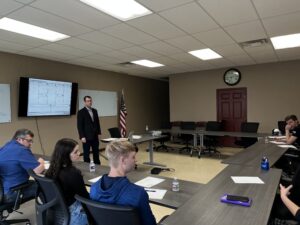
The Importance of Customer Discovery: Know Your Audience and Know Your Market
By: Sunnie Dawn Baker Entrepreneurs and small business owners must consider many factors to achieve success, with their target market being one of the most crucial. Sometimes, when people are
What Does Economic Development Do for You? The Significance of the Economic Multiplier
By: Sunnie Dawn Baker People often find the term “economic development” vague and confusing. Understanding how economic development works and benefits the community can be challenging. Though there are many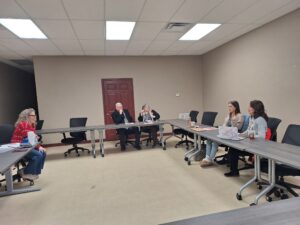
Helping Entrepreneurs One Workshop at a Time: Lauri Rowe and QuickBooks for Small Businesses
Entrepreneurs tend to be filled with passion and big ideas. They have found a solution to a problem they see in the world, and they barrel ahead, excited for their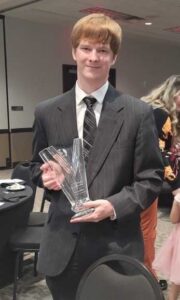
Hunter Cook: Technology, Entrepreneurship, and the Written Word
By: Sunnie Dawn Baker Hunter Cook started writing when he was seven years old. At first, he wanted to write comic books, but then he realized he couldn’t draw. He
Empowering Native Artists: FAME App Brings Innovation to First American E-Commerce
By: Sunnie Dawn Baker Entrepreneurs are problem solvers. They are constantly striving for solutions to issues they see in the world or in their own lives. In the case of
Learn, Connect, and Grow: 2025 Workshops for Aspiring and Current Business Owners
By: Sunnie Dawn Baker A new year brings new possibilities, and, at the Ada Jobs Foundation, it also brings a new round of programming and workshops. As the local Economic